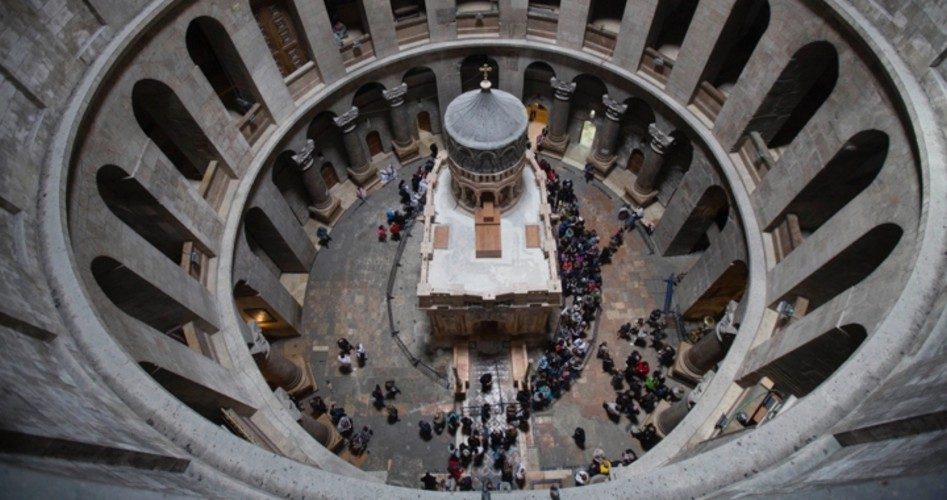
The location of the tomb that held the body of Jesus Christ before His resurrection has been in dispute for centuries, and recent scientific tests do not purport to settle that issue. But the tests do support the assertion that the Romans built a monument at the Jerusalem site in the fourth century, at the direction of Emperor Constantine the Great.
Antonia Moropoulou, the chief scientific coordinator of the restoration works, explained, “This is a very important finding because it confirms that it was, as historically evidenced, Constantine the Great responsible for cladding bedrock of the tomb of Christ with the marble slabs in the edicule.” The edicule, a shrine that encases the tomb, was constructed in the 19th century, and is today found inside of the Church of the Holy Sepulchre (shown). The site’s custody is shared by the Greek Orthodox, Armenian, and Roman Catholic churches.
The other contender with the most evidence for having been the tomb of the founder of Christianity is the “Garden Tomb,” discovered in the 19th century outside the old city of Jerusalem.
Supporters of the Church of the Holy Sepulchre site point to the tradition that Constantine had the monument to Jesus built on the site of his burial after Constantine’s conversion to Christianity early in the fourth century. The scientific tests on mortar at the site are considered consistent with the assertion that Constantine had the monument built around A.D. 326, but do not offer any further evidence for the contention that this is the actual site of the temporary burial of Jesus in the fourth decade of the first century.
Constantine claimed that he was able to win a key battle for control of the Roman Empire after seeing a blazing cross in the sky, with the words In Hoc Signo Vinces (Latin for “In This Sign Conquer”). Praying to the Christian God, Constantine won the battle, and with it rule over the whole of the Empire. Soon after this, Constantine issued the Edict of Milan, which legalized the Christian religion. Before this time, Christians had suffered intermittent persecution, some of it incredibly severe, at the hands of the Romans.
After his conversion, Constantine used his position as emperor to promote the Christian faith. Among his actions was sending a delegation of Romans to Jerusalem in 325 to locate Christ’s tomb. Tradition states that they were told that a Roman temple, built about 200 years earlier, was over the site. The temple was torn down, and excavations beneath did reveal a tomb hewn from a limestone cave.
One argument in favor of the Church of the Holy Sepulchre being the actual burial site of Jesus is that the site also stands on a Jewish cemetery that dates to the time of Jesus.
The dispute as to whether the Garden Tomb or the site found within the Church of the Holy Sepulchre is the actual burial site of Jesus naturally raises the question of just why there is such a dispute. After all, why did not the early Christians more precisely locate a site which is so prominent in the gospel accounts of the resurrection of Jesus, found in the New Testament accounts by Matthew, Mark, Luke, and John?
Whether the body of Jesus was placed in the site that Constantine’s representatives chose, or the Garden Tomb, the fact is that there is not a body there now. In short, the primary reason that Christianity spread so rapidly in the first century and beyond to Constantine’s day was that Christians believed that the body of Jesus was not in any tomb. They believed He rose from the dead.
Had they believed that the body of Jesus was in either tomb on the Sunday following His execution on a Roman cross, there would be no Christian religion at all. Jesus would have been a footnote in history, if that. But because the early Christians did not believe the body of Jesus was in either tomb — because He had risen from the dead — the tomb’s location was simply not a matter of great import to those early Christians.
Today, Christians who pilgrimage to Israel are often treated to the arguments for which of the two proposed sites is the actual tomb of Christ. But whichever site is the actual location (no other proposed locations are taken very seriously), no Christian pilgrim is expecting to see the body of Jesus inside the tomb.
Photo of the Edicule in the Church of the Holy Sepulchre: AP Images



